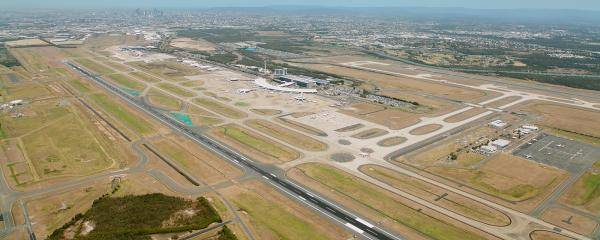Learn about the different runway operational modes at Brisbane Airport and view operational reports on runway operation usage and forecasts.
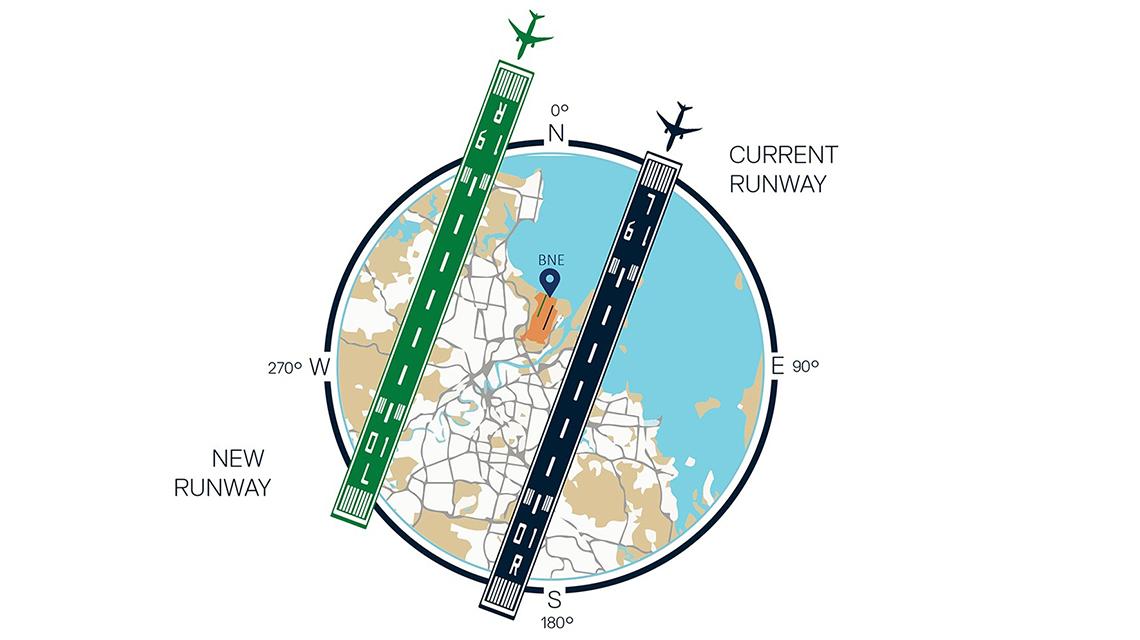
In order for air traffic controllers and pilots to know the appropriate runway for take-off or landing, runways are always described using two numbers. Each number represents the orientation of the runway on a compass.
Based on compass orientation, Brisbane Airport’s legacy runway is described as 01/19 (010 degrees magnetic / 190 degrees magnetic). As the runways are parallel to each other, ‘L’ for left and ‘R’ for right has been added to all directions on both runways to distinguish between the two.
Therefore, the eastern lying runway is described as 01R/19L and the western lying runway is described as 01L/19R.
Any aircraft using 01 will either be arriving over the city or taking off over the bay. Any aircraft using 19 will be either arriving over the bay or taking off over the city.
Brisbane Airport uses parallel runway operations with three main modes of operation (there are other modes available however these are the most common):
Simultaneous parallel operations (Southerly Wind) where all flights land over the bay and take off over the city from both runways. This means arrivals and departures on both runways at the same time in a southerly flow of traffic.
Simultaneous parallel operations (Northerly Wind) where all flights land over the city and take off over the bay from both runways. This means arrivals and departures on both runways at the same time in a northerly flow of traffic.
Simultaneous opposite direction parallel runway operations (SODPROPS) where flights both land and take off over the bay simultaneously. This is the preferred mode for night time operations.
Air Traffic Controllers within Airservices Australia ultimately make the decision at the time on the mode of operation. When selecting the mode, they consider traffic volume, complexity, weather and any other relevant factors, with safety as their primary consideration.
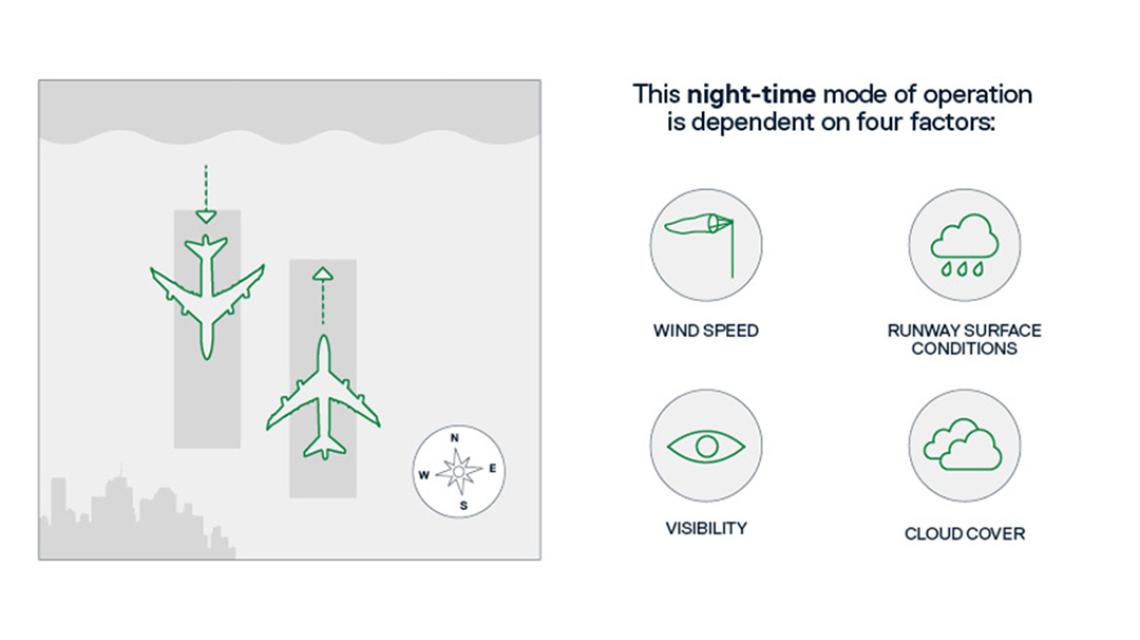
Between 10pm – 6am, the preference is for all overnight arrivals and departures to occur over the bay. The preferred mode for this is Simultaneous Opposite Direction Runway Operations (SODPROPS). The use of SODPROPS is weather dependent and based on four factors – visibility, cloud cover, wind speed and runway surface conditions.
If over the bay operations are possible, arriving aircraft will land on the 19R and departing aircraft will use the 01R runway. This means that the initial climb and final descent of aircraft will take place over water, rather than residential areas.
If over the bay operations can’t be utilised due to weather conditions, reciprocal operations using either runway will be the next preferred option. This is also weather dependent, with both arriving and departing aircraft using the same or either runway. If over the bay operations are not possible due to weather conditions, a modified version of simultaneous parallel operations based on wind direction will be implemented.
If there are northerly winds, flights will land over the city and take off over the bay from both runways. If there are southerly winds, flights will land over the bay on both runways and take off over the city from 19L during normal operating conditions. This maintains consistency with proposed flight paths included in the Environmental Impact Statement (EIS). Aircraft can use 19R to depart overnight in certain conditions.
When aircraft arrive at Brisbane Airport, they can take one of three different approaches. The approach they take will depend on the navigational aids available on that particular aircraft.
The three approaches are:
- Instrument landing system approach (or ILS approach): requires aircraft to line up with the centreline of the runway approx. 12 nautical miles (approximately 22 kilometres) from landing. It communicates with two pieces of equipment on the ground: the localiser which provides lateral guidance and the glide slope which provides vertical guidance.
- Short approach (or RNP approach): uses satellite based technology and equipment in the aircraft to safely navigate the aircraft into landing. This does not require communication with any equipment on the ground.
- Visual approach: conducted when the weather is fine with no low cloud cover and a pilot is operating the aircraft by visual references. This approach can therefore vary by several kilometres.
The choice of which flight path to use can also be influenced by weather conditions, aircraft separation requirements and the concentration of aircraft arriving or departing at the airport.
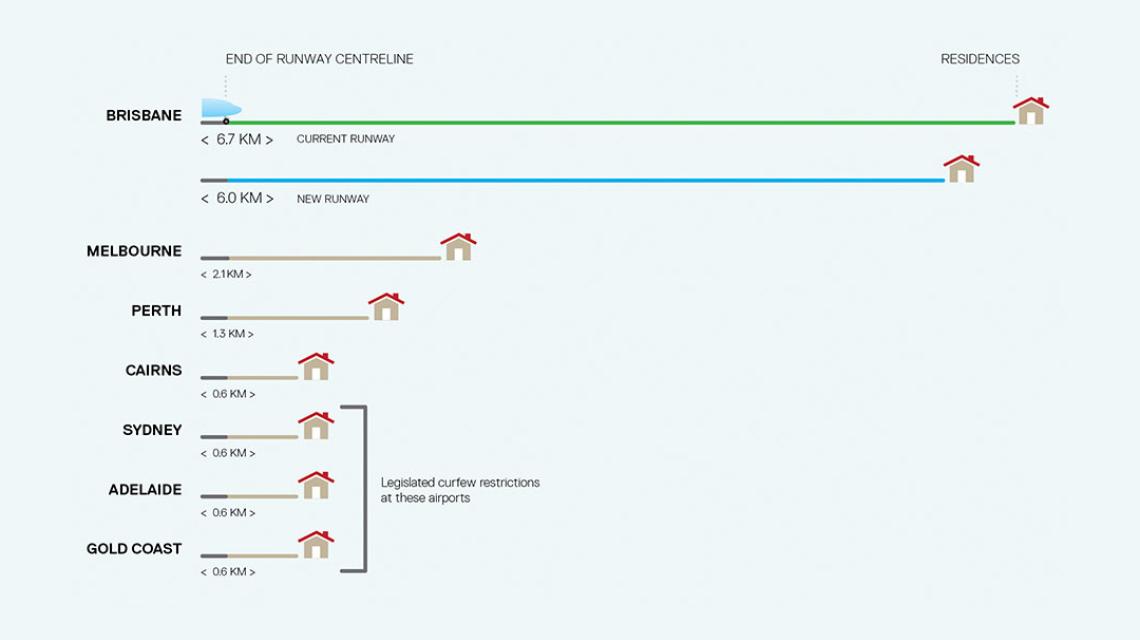
A buffer zone is measured by drawing a straight line from the centreline at the end of the runway to the nearest residences.
Brisbane Airport has the largest noise buffer zone of any capital city airport in Australia. Drawing a straight line from the end of the legacy runway, the nearest residence is 6.7km away. Using the same straight line approach, the distance from the end of the new runway to the nearest residence is 6km.
Other Australian airports with a curfew have a much smaller buffer zone, in some cases measuring just 600m from the nearest residences.
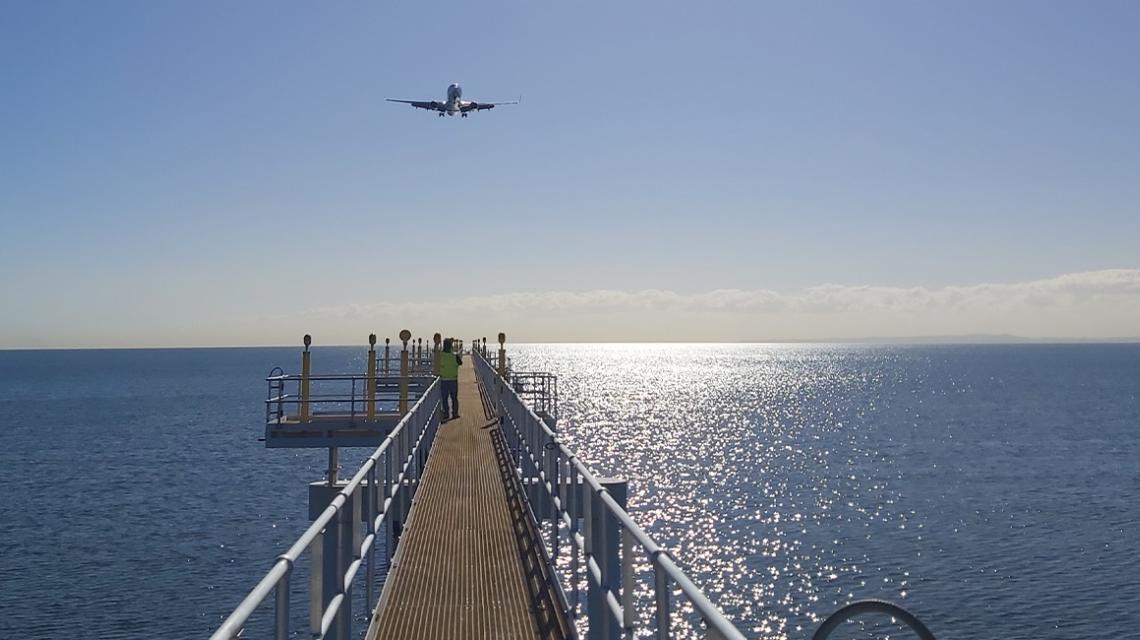
Flight paths are highways in the sky. They define three-dimensional routes that aircraft use to arrive at or depart from an airport.
They are developed in accordance with standards established by organisations including the International Civil Aviation Organization (ICAO), the Civil Aviation Safety Authority (CASA) and The Office of Airspace Regulation (OAR) and are carefully formulated to ensure the safe and efficient operation of aircraft.
We have developed a series of dashboards using data from ADSB Exchange and our independent noise monitoring technology (Casper Noise), Airservices Australia, Bureau of Meterology and WeatherZone. This includes historical reporting on overnight operations and runway directional usage, on-time performance as well as forecasted directional use. Information can be filtered on the reports, with historical data available for comparison from 2017 onwards.
Runway Usage
The direction in which aircraft are able to take-off and land is determined by the wind speed and direction at the airport. As a general rule, aircraft must take-off and land into the wind.
The preferred mode of operation overnight (10pm-6am) is for all aircraft to arrive and depart over the bay, to minimise the impact of noise on the Brisbane community. However this is weather dependant and based on four factors; wind speed, visibility, cloud cover and runway surface conditions.
This chart shows the historical data for over the bay operations and the direction of flights on the runways at Brisbane Airport.
- North (northerly/easterly winds) = where flights land over the city and take-off over the bay.
- South (southerly/westerly winds) = where flights land over the bay and take-off over the city.
Data source: Anoms and Casper
Runway Usage Forecast
The mode of operation of the runway system is determined by the wind speed and direction at the airport. This chart provides planned modes of operation based on the weather forecast at Brisbane Airport for the next 54 hours. This forecast does not take into consideration the traffic and complexity at a given time that Air traffic Control must manage which is a significant contributor to which mode is used. Additionally, there may be some discrepancy between the BOM forecast data and actual weather data measured on the airport at the time of mode selection. The weather data collated by Air Traffic Control Anenometers and aerodrome conditions comes from Aeronautical Terminal Information Service (ATIS).
Note: data is updated daily at midday for the next 54 hours. Source: Bureau of Meteorology Aviation Weather Service and Weatherzone.
On-time Performance
On-time performance (OTP) measures the percentage of flights that are considered ‘on-time’, which is arriving or departing within 15 minutes of the scheduled time. This is an industry standard used by both airlines and airports to benchmark and improve on operating performance.
Whilst delays such as bad weather on the flight paths into Brisbane, or even at a connecting destination, like Sydney or Melbourne can have on onflow impact right across the domestic network, in Brisbane, parallel runway operations are critical to reducing operational delays into the future.
Note: data is updated monthly for the previous month. Source: Airservices Australia

